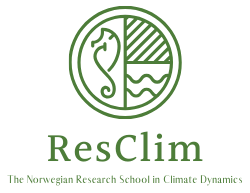Norwegian Research School in Climate Dynamics
The main objective of the Norwegian Research School in Climate Dynamics is to establish an internationally recognised research training environment for PhD candidates in climate dynamics, giving them in-depth knowledge in their specific study field within climate research, trans-disciplinary knowledge in the dynamics of the entire climate system, insight into the political and societal impacts of climate change, and the necessary skills to play an active role in appropriately predicting, mitigating, and adapting to climatic and environmental change.
Scientific motivation
Northwest Europe owes its mild favourable climate to the northward transports of heat associated with the North Atlantic storm tracks and the North Atlantic- and Norwegian Atlantic Currents, the northern extensions of the Gulf Stream. As a result of these large-scale heat transport mechanisms in the atmosphere and ocean, the climate in our region is 10-15 degrees warmer than the mean for the same latitudes. The climate is further characterized by strong year-to-year and decade-to-decade variability, making it particularly challenging to separate anthropogenic (man-made) climate changes from natural variability in this complex part of the Earth’s climate system.
At present we do not know to which extent this is related to anthropogenic forcing, or if the next few decades will show further amplification or a return to more normal conditions. Experiments with climate models indicate that both may be possible, and that natural variability can dominate over global warming for several decades. Yet the demand for societal planning and risk ablation requires that we have at hand improved knowledge that enables a much better prediction of the system.
Northwest Europe and northern North Atlantic is 10-15°C warmer than the annual mean temperatures for the same latitudes (colour scale). This is due to the heat and moisture being transported by the storms from southwest (blue curves) and the heat being transported by the northern extension of the Golf Stream (red). The dependency on heat import and strong local feedbacks cause large year-to-year and decade-to-decade variability in the climate of the region. To improve the regional-scale climate scenarios, better prediction of the future storm tracks and ocean circulation are required.


Strongly related to sensitivity and feedbacks is to which extent there exist thresholds or so-called tipping points in the climate system, where non-linear feedback effects can result in rapid transitions from one climate state to another. Much-quoted examples from the past are the rapid shifts that have occurred in the ocean circulation and land temperatures in our region, often triggered by large fresh water outbursts from land associated with iceberg calving or breaking ice dams. Other perhaps more imminent questions relate to the possibility of a sudden transition to an ice-free Arctic, an abrupt out gassing of methane associated with melting permafrost, a strong acceleration in the melting of the Greenland ice sheet and associated sea-level rise, a significant reduction in the net oceanic uptake of CO2 enhancing global warming, or large ecosystem changes through oceanic uptake of CO2 and subsequent acidification.
Perhaps the most exigent societal question of our time is to what degree, and at what pace, mitigation and adaptation strategies should be implemented in everyday politics. The success of all future political measures will strongly depend on the right input data from the climate community, making it more than ever before important to train future generations in the complex dynamics of the climate system. Related to this complexity is the need for collaboration between scientists of various skills, whether they have their expertise in the atmosphere, ocean, sea ice, biogeochemical cycling, or in climate modelling, and a need for scientists to be able to communicate to non-scientist to a much larger extent than before. The most efficient way to foster such a research training environment is to make a forum where the young scientists from the various institutions can meet, be trained in-depth and in breadth, be introduced to national and international networks, get the chance to exchange experiences and ideas, and simply make friends for life-long networks.
Description of activities
In order to strengthen the national research training, the following activities are part of the Norwegian Research School in Climate Dynamics:

